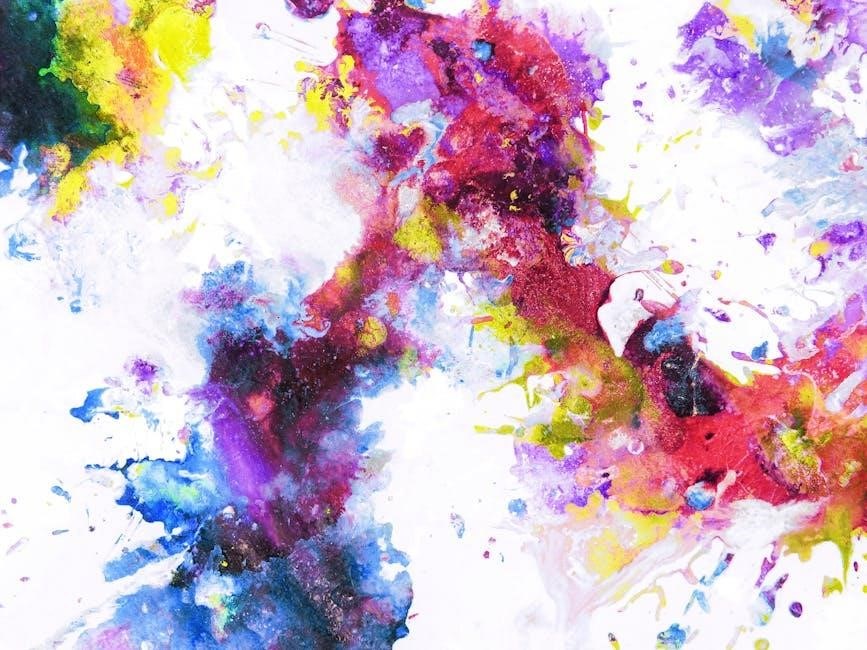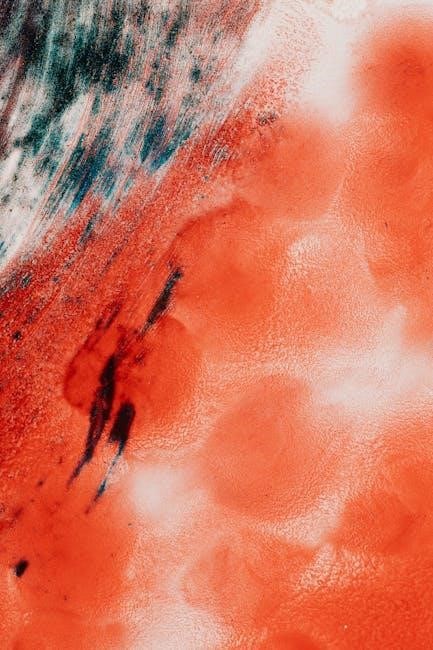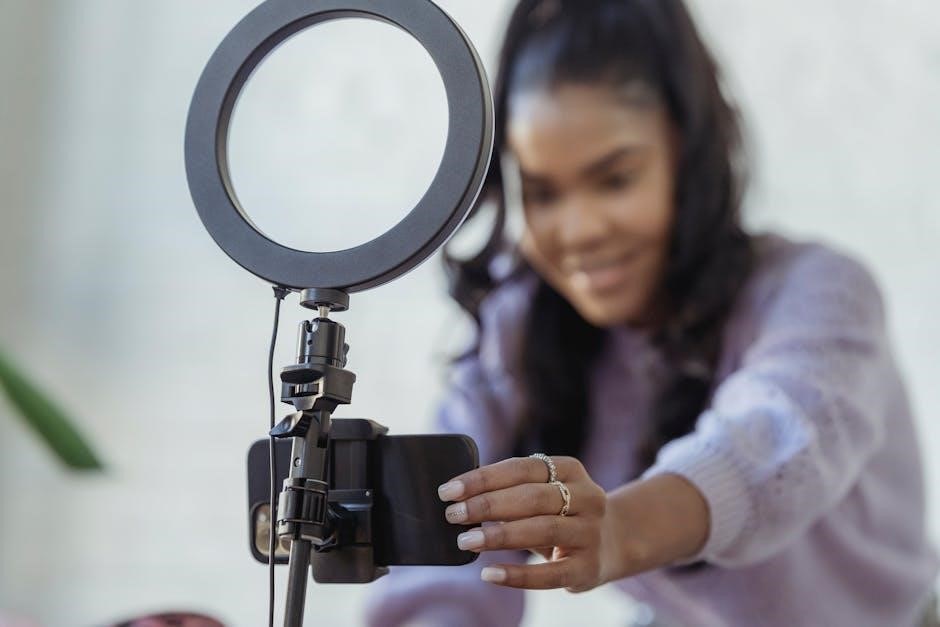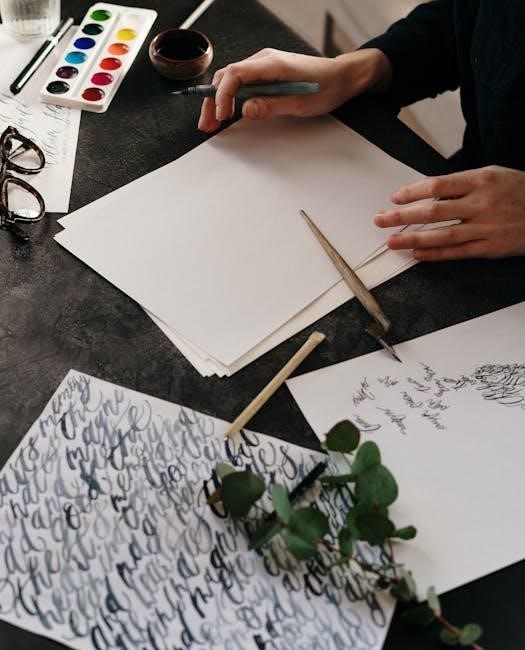Watercolor Tutorial PDF: A Comprehensive Guide
Unlock your artistic potential with our comprehensive guide to watercolor painting, delivered in a convenient PDF format.
From basic techniques to advanced tips, this resource is designed for artists of all skill levels, offering step-by-step instructions and inspiration.
Watercolor painting, a captivating and luminous art form, invites artists to explore a world of fluid colors and transparent layers.
This introduction serves as a gentle gateway into the realm of watercolor, perfect for beginners eager to embark on their artistic journey.
Watercolor’s unique characteristic lies in its ability to create delicate washes and vibrant hues, allowing for expressive and ethereal effects.
The beauty of watercolor stems from its unpredictable nature, where water and pigment dance together to create stunning results.
Whether you aspire to paint picturesque landscapes, expressive portraits, or abstract compositions, watercolor offers a versatile medium to bring your artistic visions to life.
Embrace the fluidity and transparency of watercolor, and discover the joy of layering colors to achieve depth and dimension in your artwork.
This section will cover the core principles of watercolor, including understanding paint properties, working with water ratios, and mastering fundamental techniques.
Prepare to delve into the world of washes, blending, and layering, as we guide you through the initial steps of watercolor painting.
With practice and patience, you’ll gain confidence in controlling the medium and expressing your unique artistic style through watercolor.
Essential Watercolor Supplies for Beginners
Embarking on your watercolor journey requires gathering the right tools to set you up for success.
This section outlines the essential supplies that every beginner watercolor artist should have in their arsenal.
From paints and brushes to paper and palettes, we’ll guide you through the selection process, ensuring you have everything you need to start creating beautiful watercolor art.
Investing in quality watercolor paints is crucial for achieving vibrant and lasting results.
Begin with a basic set of student-grade watercolors, which offer a good balance of affordability and quality.
Next, explore the world of watercolor brushes, opting for a variety of shapes and sizes to accommodate different techniques.
Round brushes are ideal for detail work, while flat brushes are perfect for creating washes and broad strokes.
Choosing the right watercolor paper is equally important, as it affects the way your paints are absorbed and blended.
Opt for cold-pressed paper, which has a textured surface that allows for better color adhesion and control.
Finally, don’t forget to equip yourself with a palette for mixing colors, a water container, masking tape, and a soft cloth for blotting excess water.
With these essential supplies in hand, you’ll be well-prepared to dive into the world of watercolor painting.
Basic Watercolor Techniques: Washes and Blending
Mastering basic watercolor techniques is essential for creating stunning artwork.
This section delves into the fundamental techniques of washes and blending, providing you with the knowledge and skills to achieve smooth, even color transitions and captivating effects.
Whether you’re a complete beginner or an experienced artist looking to refine your skills, this guide will help you unlock the full potential of watercolor painting.
Washes are the foundation of watercolor painting, providing a base layer of color and tone.
Learn how to create flat washes for uniform backgrounds, graded washes for smooth transitions, and variegated washes for dynamic color variations.
Experiment with different water-to-paint ratios to achieve the desired level of intensity and transparency.
Blending techniques allow you to seamlessly merge colors and create soft, natural transitions.
Explore wet-on-wet blending, where colors are applied to a wet surface, resulting in soft, diffused edges;
Alternatively, try wet-on-dry blending, where colors are applied to a dry surface, allowing for more control and precision.
Practice these techniques to develop your own unique style and create breathtaking watercolor paintings.
Remember, practice makes perfect, so don’t be afraid to experiment and explore the endless possibilities of watercolor.
Wet-on-Wet vs. Wet-on-Dry Techniques
Understanding the nuances of wet-on-wet and wet-on-dry techniques is crucial for controlling the flow and appearance of your watercolor paints.
Each technique offers unique advantages, allowing you to achieve different effects and textures in your artwork.
This section provides a detailed comparison of these two fundamental approaches, guiding you through their applications and helping you choose the right technique for your desired outcome.
Wet-on-wet involves applying wet paint to a wet surface, resulting in soft, diffused edges and unpredictable color blending.
This technique is ideal for creating dreamy landscapes, atmospheric skies, and loose, expressive washes.
Embrace the fluidity of the medium and allow the colors to mingle organically on the paper.
Wet-on-dry, on the other hand, involves applying wet paint to a dry surface, providing greater control and precision.
This technique is suitable for detailed illustrations, sharp edges, and layering colors without excessive bleeding.
Experiment with both techniques to discover their strengths and weaknesses and develop your own personal style.
Mastering these techniques will open up a world of possibilities in your watercolor journey.
Ultimately, the choice between wet-on-wet and wet-on-dry depends on the desired effect and the artist’s preference.
Color Mixing for Watercolor: A Beginner’s Guide
Embark on a colorful adventure with our beginner’s guide to color mixing for watercolor.
Understanding color theory and how to mix paints effectively is essential for creating vibrant and harmonious watercolor paintings.
This section will demystify the color wheel, explore primary, secondary, and tertiary colors, and provide practical tips for achieving a wide range of hues and shades.
Learn to mix colors accurately and avoid muddy or dull results.
Discover the power of a limited palette and how to create a full spectrum of colors with just a few essential pigments.
Explore different color mixing techniques, such as glazing and layering, to achieve depth and complexity in your paintings.
Practice mixing colors regularly to develop your intuition and understanding of how different pigments interact.
This guide will equip you with the knowledge and skills to confidently mix colors and create stunning watercolor artwork.
Experiment with warm and cool colors, learn to create neutral tones, and discover the magic of color relationships.
Unleash your creativity and express yourself through the art of color mixing.
Remember, color mixing is a journey of exploration and discovery, so embrace the process and have fun experimenting with different combinations.
Soon, you’ll be able to mix any color you desire with confidence and precision.
Free Watercolor Tutorials for Download
Elevate your watercolor skills with our collection of free downloadable tutorials.
Access a variety of resources designed to guide you through different techniques, subjects, and styles.
Whether you’re a beginner or an experienced artist, these tutorials offer valuable insights and practical exercises to enhance your abilities.
Explore topics ranging from basic washes to advanced layering, and discover new ways to express your creativity with watercolor.

Download step-by-step instructions, detailed illustrations, and helpful tips to improve your painting process.
Learn from experienced artists and instructors who share their expertise and passion for watercolor.
These free tutorials cover a wide range of subjects, including landscapes, florals, portraits, and still life.
Expand your artistic horizons and discover new techniques to incorporate into your own artwork.
Take advantage of this opportunity to learn from the best and grow as an artist.
Download these free watercolor tutorials today and start your journey towards mastering this beautiful medium.
With a wealth of knowledge at your fingertips, you’ll be able to create stunning watercolor paintings that capture your unique vision.
Explore and enjoy the world of watercolor!
Step-by-Step Watercolor Painting Exercises
Enhance your watercolor skills with our collection of step-by-step painting exercises.

These exercises are designed to help you master fundamental techniques and build confidence in your abilities;
Whether you’re a beginner or an experienced artist, these exercises offer valuable practice and guidance.
Each exercise includes clear instructions, helpful tips, and illustrative examples to ensure your success.
Focus on developing essential skills such as color mixing, brush control, and layering techniques through these structured activities.
Explore a variety of exercises that cover different subjects, including landscapes, florals, and still life.
Learn how to create realistic textures, capture light and shadow, and develop your own unique style.
These exercises are designed to be both educational and enjoyable, providing you with a fun and rewarding learning experience.
Gain confidence in your ability to create beautiful watercolor paintings by working through these carefully crafted exercises.
Follow the step-by-step instructions and watch your skills improve with each exercise.
These exercises are perfect for both beginners and experienced artists who want to refine their techniques.
With consistent practice, you’ll be able to create stunning watercolor paintings that showcase your talent and creativity.
Start your artistic journey now!
Painting Skies and Water in Watercolor
Mastering the art of painting skies and water in watercolor can dramatically enhance your landscapes.
This section provides detailed guidance on creating realistic and captivating skies, from serene blue horizons to dramatic storm clouds.
Learn how to blend colors seamlessly to capture the subtle gradients of the sky and create depth and dimension.
Discover techniques for painting various types of clouds, including cumulus, stratus, and cirrus, using different brushstrokes and washes.
Understand how to use masking fluid to preserve highlights and create dynamic compositions.
Explore the nuances of painting water, from calm lakes and tranquil rivers to crashing waves and turbulent seas.
Learn how to depict reflections accurately, capturing the surrounding environment and adding depth to your paintings.
Discover techniques for creating realistic textures, such as ripples, waves, and foam, using dry brush and layering methods.
Understand how to use different watercolor techniques to convey the movement and energy of water.
Learn to paint reflections.
Experiment with different color palettes to capture the mood and atmosphere of various times of day and weather conditions.
Practice creating smooth transitions between colors to achieve a realistic and harmonious effect.
With these techniques, you’ll be able to create breathtaking skies and water scenes that bring your landscapes to life.
Start exploring!
Creating Textures in Watercolor
Adding texture to your watercolor paintings can bring depth, realism, and visual interest to your artwork.
This section explores a variety of techniques for creating different textures, from rough surfaces to smooth gradients.
Learn how to use dry brush techniques to create a gritty, textured effect, perfect for depicting rocks, tree bark, and other natural elements.
Discover the magic of salt techniques, which can create unique and unpredictable textures as the salt absorbs the pigment.
Experiment with lifting techniques, using a clean, damp brush or sponge to remove paint and reveal underlying layers, creating subtle variations in texture.

Explore the use of masking fluid to protect certain areas of your paper, allowing you to create detailed textures without worrying about overlapping colors.
Learn how to use spattering techniques to create a random, speckled texture, ideal for depicting foliage, sand, or snow.
Discover the possibilities of using textured paper, which can add a subtle, built-in texture to your paintings.
Understand how to layer different textures to create complex and dynamic effects.
Practice combining different techniques to achieve a wide range of textures, from delicate fabrics to rugged landscapes.
Experiment with different tools, such as sponges, rags, and textured brushes, to create unique and interesting textures.

With these techniques, you’ll be able to add depth and dimension to your watercolor paintings and create truly captivating works of art.
Start experimenting!
Watercolor Painting with Ink and Other Mixed Media
Elevate your watercolor paintings by incorporating ink and other mixed media elements.
This section explores the exciting possibilities of combining watercolor with various materials to create unique and expressive artworks.
Learn how to use waterproof inks to create bold outlines, intricate details, and contrasting textures alongside your watercolor washes.
Discover the versatility of pen and ink techniques, such as hatching, cross-hatching, and stippling, to add depth and dimension to your paintings.
Explore the use of colored pencils to enhance details, add subtle shading, and create interesting textures.
Experiment with incorporating collage elements, such as paper, fabric, or found objects, to add layers of texture and visual interest to your artwork;
Learn how to use acrylic inks to create bold, opaque accents and contrasting colors.
Discover the possibilities of using masking fluid to protect certain areas of your painting, allowing you to add ink or other media without affecting the underlying watercolor washes.
Understand how to layer different media to create complex and dynamic effects.
Practice combining different materials and techniques to achieve a wide range of effects, from delicate and ethereal to bold and graphic.
Experiment with different surfaces, such as watercolor paper, mixed media paper, or canvas, to see how they interact with different media.
With these techniques, you’ll be able to push the boundaries of watercolor painting and create truly unique and innovative artworks.
Troubleshooting Common Watercolor Problems
Even experienced watercolor artists encounter challenges.
This section provides solutions to common problems, helping you overcome obstacles and improve your technique.
Address issues like backruns (blooms), where unwanted water flows back into a wash, by controlling water ratios and tilting your paper.
Learn to prevent muddy colors by avoiding overmixing and understanding color theory.
Discover methods to fix mistakes, such as lifting color with a clean brush or using masking fluid for corrections.
Understand how paper type affects your results and choose the right one for your style.
Tackle problems with uneven washes by using a large, soft brush and applying paint smoothly.
Learn to control the drying time of your watercolors by adjusting the humidity and temperature of your workspace.
Prevent your paper from buckling by stretching it properly before you begin painting.
Discover solutions for lifting unwanted pigment, such as using a clean, damp brush or blotting with a paper towel.
Address issues with hard edges by softening them with a clean, damp brush or using a wet-on-wet technique.
Understand how to choose the right brushes for different techniques and effects.
Learn to avoid common mistakes in composition and design by studying the principles of art.
With these troubleshooting tips, you’ll be able to confidently tackle any watercolor challenge and create beautiful paintings.
